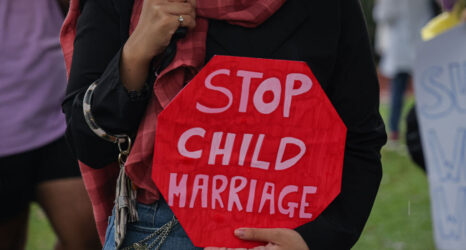Monday was International Day for the Elimination of Sexual Violence in Conflict, a day first designated in 2015 to raise awareness of the need to end this type of violence and to honor the victims and survivors. It’s a day that we shouldn’t need to have and yet need now more than ever.
Statistically, a quarter of all women in complex humanitarian emergencies experience sexual violence, compared to seven percent globally. Headlines and articles on the topic often talk about gender-based violence (GBV), but tend to have an almost myopic focus on sexual violence, as exemplified by articles characterizing ISIS’ capture of women for use as sexual slaves as one of their most “versatile weapons of war.”
Yet, what is not as well-understood is that there is a much broader range of gender-based violence that increases during emergencies, such as intimate partner violence (violence where the perpetrator is a spouse or intimate partner). Sometimes referred to as domestic violence, intimate partner violence is the most common form of gender-based violence, whether in times of conflict, crisis or peace. We also know that human rights abuses and forms of gender-based violence, like child marriage and human trafficking, increase during emergencies.
The good news is that we have the evidence to know how best to prevent and respond to the full spectrum of GBV, and the United States and international community have made concrete commitments to implement those strategies. The United States has initiated several foreign policy strategies and obligations to women and girls in conflict settings that address the full range of gender-based violence, including sexual violence.
First and foremost, the United States is guided by the U.S. Strategy to Prevent and Respond to Gender-based Violence Globally, which defines the oft-misunderstood term gender-based violence as: “directed at an individual based on his or her biological sex, gender identity or perceived adherence to socially defined norms of masculinity and femininity. It includes physical, sexual and psychological abuse; threats; coercion; arbitrary deprivation of liberty and economic deprivation, whether occurring in public or private life.”
The U.S. response to the global Call to Action to Prevent Gender-based Violence in Emergencies (Call to Action) was the Safe from the Start initiative. This initiative seeks to mitigate potential exposure to gender-based violence through greater coordination and accountability, as well as through the integration of GBV prevention and response into programming from the onset of an emergency. Safe from the Start was innovative at the time it was launched, but it needs to be elevated and sustained to maximize impact.
Finally, the National Action Plan on Women, Peace and Security, first released in 2011 and last updated in 2016, attempts to institutionalize women’s inclusion and participation in preventing conflict and keeping the peace globally. It lays out three main objectives, or pillars, one of which is focused on protection. Under the protection pillar, the United States is obligated to “integrate GBV prevention efforts into areas such as education, economic growth and health, including through local partnerships, stronger service provision and improved accountability to ensure that judicial systems appropriately address perpetrators.” Integration within and across sectors is critical to address fully this terrible and often preventable form of violence.
At an ICRW event in April, Margaret Pollack, Acting Deputy Assistant Secretary of State for the Bureau of Population, Refugees and Migration for the U.S. Department of State insisted that, “the U.S. government remains committed to preventing and responding to gender-based violence.” For this commitment to ring true, all relevant U.S. government agencies (Department of State, the U.S. Agency for International Development or USAID, and the Department of Defense) and implementers receiving U.S. funding need to intensify existing efforts and build on previous efforts to prevent and respond to GBV from the onset of an emergency or crisis. For far too long, GBV was an afterthought in emergencies, leaving already vulnerable populations without even the most basic protections from violence, often at the hands of loved ones and community members.
The United States has several obligations that it must meet and exceed, not only as a moral obligation to protect already vulnerable women and girls from further exploitation and violence, but because there is evidence that levels of violence against women are an excellent predictor of whether a state is stable, peaceful, wealthy or at risk for descending into conflict and violent extremism. The violence women and girls disproportionately experience has serious impacts, on the individual women and girls but on their communities and countries as well.
Congress has appropriated $150 million dollars annually from fiscal year 2013 through 2016 to prevent and respond to gender-based violence. This is a strong foundation for future progress, though that progress comes into question in the current political environment. For example, the Trump Administration’s budget request for FY18 was even more devastating to humanitarian response than his so-called “skinny budget” — expanding from a proposed 28 percent cut to international affairs accounts to 32 percent. In fact, programs specifically designed to help women and girls are cut by a baffling 61 percent in his proposal.
There are continued discussions on how the architecture of USAID and the Department of State will work moving forward, including the agencies and offices responsible for the bulk of gender-based violence prevention and response work. The President’s proposal could fold USAID into the Department of State, and drastic layoffs have been proposed regardless of the budget ultimately passed by Congress. These moves, in practice, would not reduce inefficiencies and streamline the two agencies, but instead would lead to the loss of some of America’s most respected minds in development and diplomacy, and a muddling of the mandates of both agencies both of which are necessary for addressing GBV. Were the budget to be enacted as-is, it would have deadly consequences.
Despite a recent statement by Secretary of State Rex Tillerson, where he noted that American foreign policy will no longer prioritize human rights as part of the new America First approach, the United States must hold strong on our promises to women and girls in conflict. It is vital that the United States continue to act to prevent violence against women and girls already suffering from conflict and violence. ICRW has long recommended a greater focus on the unique needs of adolescents, for whom little programming exists, particularly younger adolescents aged 10-14. ICRW has outlined several recommendations in a policy brief that go above and beyond the rape as a weapon of war headlines and link to the existing policy framework for readily implementable action.
Since World War II, the United States has been a leader in humanitarian response. Despite reassurances from administration officials that we still care, the world’s women and girls can only hope that the United States continues to put our money where our mouth is as Congress finalizes the FY18 budget. This country can be the one to move the needle in addressing sexual violence in conflict and all forms of GBV. We can honor survivors by preventing future women and girls from becoming victims, and setting up systems to address the needs of survivors from the onset of any conflict.
The lives of women and girls the world over are at stake—not for a single day, but every day.





